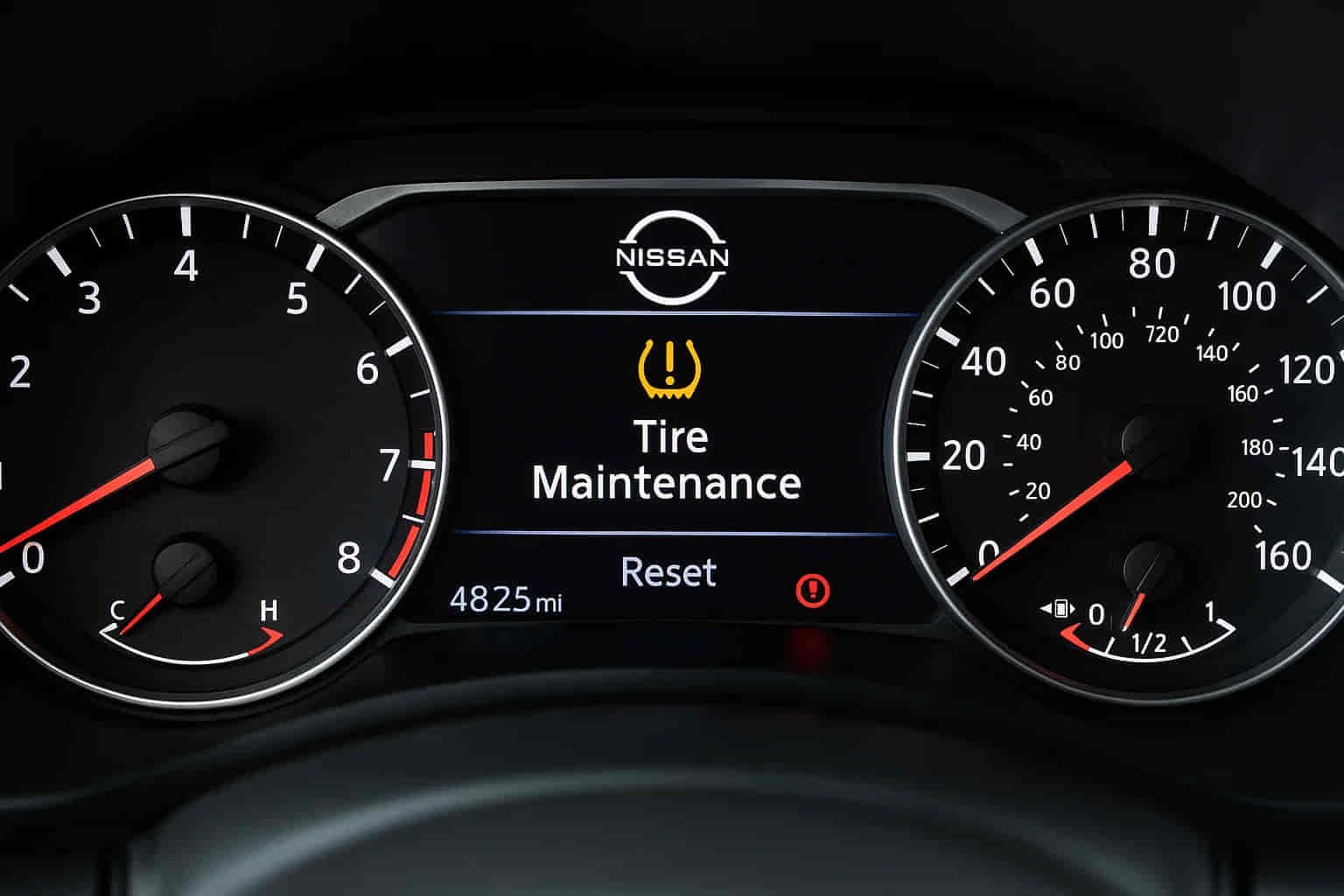If you are driving a Nissan and suddenly notice the tire maintenance light on your dashboard, it can feel confusing and even a bit frustrating. Many drivers mistake it for the tire pressure warning, but in reality, this light has a completely different purpose. It is not alerting you to a flat tire—it is simply reminding you that your vehicle needs regular tire service, usually a rotation based on mileage.
The problem is that once the service is complete, the light often stays on until you manually reset it. Visiting a dealership just to clear this reminder can cost both time and money, even though the process only takes a few seconds if you know the right steps. That is why understanding the Nissan tire maintenance light reset procedure is so valuable for every owner.
In this guide, you will discover exactly how to reset the light across different Nissan models, why it appears in the first place, and how proper tire care can save you from bigger issues down the road. By the end, you will feel confident handling this task yourself—without the stress of unnecessary service fees.
What Does the Nissan Tire Maintenance Light Mean?
When the tire maintenance light appears on your Nissan’s dashboard, it is not signaling an emergency. Instead, it works as a built-in reminder set by the vehicle’s maintenance system. This light is programmed to turn on after a specific mileage interval, usually around every 5,000 to 7,500 miles, which is when Nissan recommends a tire rotation. By rotating the tires at the right intervals, you extend their lifespan, maintain balanced traction, and keep fuel efficiency at an optimal level.
The most common mistake drivers make is confusing this light with the tire pressure monitoring system (TPMS) warning. While the TPMS indicates an actual pressure problem in one or more tires, the tire maintenance light has nothing to do with inflation. Its only job is to remind you that scheduled tire care is due. Ignoring it will not cause immediate harm, but failing to perform regular maintenance can lead to uneven wear and costly replacements later on.
In short, when this light appears, it is your Nissan’s way of reminding you to take care of your tires before problems arise. The good news is that once the service is completed, you can easily reset it yourself without visiting a dealership.
When Should You Reset the Tire Maintenance Light?
Resetting the Nissan tire maintenance light is not something you should do randomly. The reminder exists for a reason, and clearing it without completing the recommended service could cause you to lose track of your vehicle’s maintenance schedule. The ideal time to reset the light is immediately after performing a tire rotation, replacing your tires, or completing any service related to wheel alignment and balancing. This ensures the reminder stays synchronized with your actual maintenance history.
For most Nissan models, the interval is tied to mileage rather than time. That means the light may come on even if you have not noticed any issues with your tires. Ignoring it for too long can lead to uneven tread wear, reduced handling performance, and unnecessary fuel consumption. By resetting it only after the work is done, you preserve an accurate log of your tire care and avoid potential safety risks.
Think of this reset as closing the loop in your maintenance routine: service, confirm, reset. It is a small but crucial step that keeps your Nissan’s system aligned with the real condition of your vehicle. Done correctly, it saves you money, maximizes tire life, and maintains driving confidence.
Step-by-Step Nissan Tire Maintenance Light Reset (All Models)
Performing a Nissan tire maintenance light reset is far easier than most drivers expect. Although the menu layout can vary slightly between models, the overall process follows the same simple pattern. Once you know it, you will never need to pay a dealership just to clear the reminder.
Start by turning the ignition key to the “ON” position without starting the engine. On push-button start models, this means pressing the start button twice without stepping on the brake. Once the dashboard lights are active, use the steering wheel controls or the INFO button, depending on your Nissan, to navigate through the settings menu. Look for the section labeled “Maintenance,” then select “Tire.”
Inside this menu, you will see the mileage interval currently stored. To reset, highlight the “Reset” or “Clear” option and confirm. In most cases, the tire maintenance light will disappear instantly. If it does not, switch the ignition off, restart the car, and check again.
This process only takes a minute, but it saves you from unnecessary appointments at the dealership. More importantly, it keeps your maintenance reminders accurate, so you always know when the next service is due.
Model-Specific Reset Instructions
While the general reset process is similar across all Nissan vehicles, each model has its own small variations that can confuse drivers. Understanding these differences ensures you reset the tire maintenance light correctly without second-guessing the steps.
For Nissan Altima owners, the process typically involves using the INFO button near the dashboard. Once the ignition is on, you navigate to the “Maintenance” section, choose “Tire,” and confirm the reset. The Rogue, on the other hand, relies on its multi-function display controlled by steering wheel buttons. You scroll through the settings until you reach “Maintenance,” select “Tire,” and then reset.
Sentra and Maxima models follow a nearly identical method, but their menus can appear slightly different. In some versions, you may need to press the square button on the dashboard repeatedly to reach the correct screen. Pathfinder and Frontier drivers should expect a similar flow, although trucks and SUVs often have a longer menu path before you reach the tire maintenance option.
The key takeaway is that no matter the Nissan model—sedan, SUV, or truck—the reset process always revolves around accessing the maintenance menu and confirming the reset. Once you understand this logic, adapting it to your vehicle becomes straightforward.
Common Issues if the Light Doesn’t Reset
Sometimes, even after carefully following the steps, the Nissan tire maintenance light refuses to disappear. This situation can be frustrating, especially if you are certain the service has already been completed. One of the most common reasons is a simple mix-up with the TPMS, since many drivers attempt to reset the tire pressure system instead of the maintenance reminder. If the wrong menu is selected, the light will stay on.
Another frequent issue occurs when the ignition sequence is not performed correctly. On push-button start vehicles, for example, forgetting to press the start button twice without the brake pedal can prevent the system from entering the correct mode. In some cases, the reset appears successful, but the reminder comes back immediately because the confirmation step was skipped. Restarting the car and repeating the process usually solves this.
If the light persists despite multiple attempts, the underlying problem may be a software glitch or a faulty sensor in the dashboard system. At this point, a quick visit to a Nissan dealer or a trusted mechanic may be necessary to clear the reminder permanently. Still, most drivers find that with patience and careful attention to each step, the issue resolves without professional help.
Why Regular Tire Maintenance Matters for Nissan Owners
Resetting the Nissan tire maintenance light is only part of the story. The real reason this reminder exists is to protect your tires, your wallet, and ultimately your safety on the road. Tires that are neglected wear unevenly, lose traction, and shorten their lifespan dramatically. Over time, this not only forces premature replacements but also reduces fuel efficiency, making every drive more expensive than it needs to be.
For Nissan owners, keeping up with scheduled tire rotations is one of the simplest ways to preserve performance. A well-maintained set of tires keeps the car balanced, provides smoother handling, and helps avoid sudden blowouts caused by weak spots in the tread. Many drivers underestimate how much money they can save just by rotating their tires on time and ensuring proper alignment.
The maintenance light should not be seen as an annoyance, but as a helpful reminder built into your vehicle. Each reset marks the completion of a small but vital service that keeps your Nissan reliable for the long term. When you understand its purpose, pressing that reset button feels less like clearing a nuisance and more like staying in control of your car’s health.
Conclusion
The Nissan tire maintenance light reset may seem like a minor detail, but it plays a big role in keeping your car in top condition. This reminder is not there to frustrate you—it is designed to ensure your tires get the attention they deserve. By resetting it only after proper service, you maintain an accurate maintenance record, extend the life of your tires, and avoid unnecessary costs at the dealership.
What makes this process even better is that you do not need advanced mechanical skills or special tools. With just a few simple steps, you can take control of the reset yourself and keep your Nissan running smoothly. The real payoff comes in the form of safer driving, longer-lasting tires, and the peace of mind that you are staying ahead of potential problems.
So the next time this light appears, remember that it is not a warning of danger, but a nudge toward smarter vehicle care. Once you understand how easy the reset is, you will never feel the need to schedule a service appointment just for this reminder again. Which Nissan model are you driving, and have you already tried resetting the tire maintenance light on your own?

